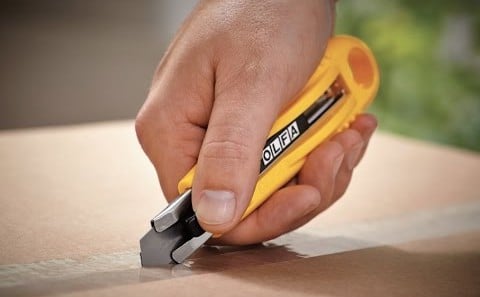Safety, along with effectiveness, should be your primary concern when choosing a knife. Many cutting tools on the market claim they’re “safe,” but what makes a safety knife safer to use? How do you know if you’re utilizing a tool that’s safe to the touch and will mitigate the risk of injuries?
Legitimate safety knives exist. However, researching ahead of time is crucial. For example, you want to find a knife with the safest blade possible. Having a safe tool like this at your disposal will not only protect you from potential lacerations, but it’ll increase your work time. Let’s dive into safety knives and what makes them safer than other cutting tools.
Safety Knife Features
When purchasing a safety knife, you want to take all of its features into consideration. It’s not just about finding a handle that reduces blade exposure. You need a safe blade and an ergonomic handle. A myriad of factors should come into play when you’re buying a safety knife.
The Blade
Initially, manufacturers worked to tweak the knife handle in an effort to limit exposure of the blade while cutting. Reduced blade exposure on a safety knife is a great starting point, but it’s only a portion of the overall puzzle. What about the blade itself?
You want to look into the components that make up the blade. Consider a safety knife blade that’s composed of zirconium oxide. It’s an advanced ceramic that’s resistant to wear and tear. Not only that, but it’s much tougher than steel or metal.
You’ll find that its longevity means less blade changes. That in itself reduces the risk of injuries and lacerations while simultaneously increasing your productivity and the quality of your work.
The last thing you want is a blade that’s dangerous to the touch and is prone to dullness after a short period of time. A dull blade can heighten the risk of accidents in the workplace. That’s why it’s worth considering a blade that’s made of zirconium oxide.
That being said, it’s ideal to do your own research and keep an eye out for new innovations in safety blade technology.
The Handle
In general, a knife handle should fit comfortably in your hand. An awkward fit can certainly lead to injuries down the line. You want to feel like you can hold your safety knife for an extended period of time without repetitive muscle strain, notably in your lower/upper arms, hands, and wrists.
Repetitive Strain Injury (RSI) can be used to describe the muscle pain that’s caused by repetitive, strenuous activity. The injury can be a result of accumulated damage over time. While cutting with a knife may seem like a menial task that shouldn’t lead to injuries, having an uncomfortable handle can play a major role in said injuries.
Be on the lookout for safety knives with handles that are composed of glass-filled nylon. It’s a lightweight, durable material that fits like a glove in your hand. Additionally, keep your eyes peeled for a knife handle that’s constructed with ergonomics in mind.
That being said, you don’t want a handle that’s too flimsy or prone to breakage. Lightweight doesn’t mean “cheaply made.”
Retractable Blade
Have you ever left your knife sitting around while the blade was still exposed? You should try as much as possible never to do that. Also, having a retraction mechanism would help eliminate the risk of lacerations from an open blade that’s not in use. Consider a safety knife with an auto-retractable mechanism.
A popular feature among safety managers is the spring-loaded slider. You simply release the said slider, and the blade automatically retracts. No harm, no foul.
In addition, there’s the self-retracting safety knife. When the blade loses contact with the cutting surface, it retracts. That’s another element that’ll help prevent hand injuries while you work.
Of course, you want to make sure that the slider on your safety knife doesn’t stick. Otherwise, that defeats the purpose of having an auto-retractable or self-retractable cutting tool.
The Risks from an Unsafe Blade
While you’re on the hunt for that perfect safety knife, it’s always best to consider the dangers of having an unsafe knife. For example, blades that are too sharp or dull can increase the risk of accidents and hand lacerations. A non-ergonomic handle can lead to repetitive muscle strain and, subsequently, injuries.
If you need to replace the blade on a regular basis due to its lack of durability, that also heightens the risk of potential lacerations. Blade exposure between cutting can result in hand injuries. It’s always good to keep these risks in mind when purchasing your safety knife.
Safety Is Key
Regardless of where you buy your safety knife, you really need to consider the features that make a safety knife specifically safer than their less-safe counterparts. Your safety should be first and foremost. Working from a place of safety will not only protect you from injuries, but your work will flourish and your productivity will increase.
Follow Home Inside for more!
